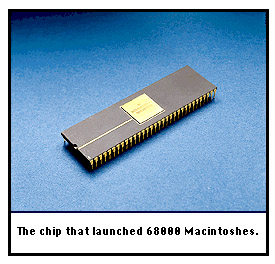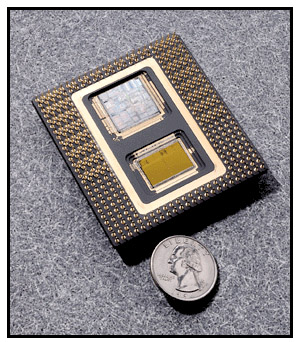| All the chips on this list, obscure as some are, had a
significant influence on the evolution of personal
computing. So what does it take to make a computer today?
Mostly, it seems, acronyms: a CPU, some RAM, a handful of
EPROMs, a DSP, and a PCI bus. Intel 1103 In 1970, Intel created the 1103 — the first generally available DRAM chip. By 1972, it was the best-selling semiconductor memory chip in the world. Today, you would need more than 65,000 of them to put 8 MB of memory into a PC. Intel 1702 In another brilliant stroke of naming, Intel created this, the first EPROM, in 1971. When you say "firmware," smile and think of the 1702. Intel 4004 In 1971, Busicom, a Japanese company, wanted a chip for a new calculator. With incredible overkill, Intel built the world's first general-purpose microprocessor. Then it bought back the rights for $60,000. The 4-bit 4004 ran at 108 kHz and contained 2300 transistors. Its speed is estimated at 0.06 MIPS. By comparison, Intel's latest microprocessor, the P6, runs at 133 MHz, contains 5.5 million transistors, and executes 300 MIPS. Intel 8080 If you drive, your life probably depends on this chip. Introduced in April 1974, the 8080 was first widely used as a traffic-light controller. It found its way a year later into the world's first personal computer: the MITS Altair. MOS Technology 6502 What do a Nintendo set and a BMW have in common? The 6502. At $25 (compared with $375 for a comparable Motorola part), the 6502 was such a steal that a talented but cash-poor whiz kid from Silicon Valley, Steve Wozniak, chose it for his new personal computer, the Apple I. Zilog Z80 Remember Tandy's TRS-80 Model I? Remember CP/M? They were both built on the Z80. Intel 8086 and 8088 Enter the King. In June 1978, the 8086 debuted. Today it stands for the world's most popular microprocessor standard: the x86 architecture. A year later, Intel introduced a slight variation, the 8088, that could use 8-bit components, enabling the manufacture of inexpensive systems. For that reason, IBM chose the 8088 over the 8086 for the original IBM PC, even though the 8088 was slower. Intel 386DX The 386 heralded the beginning of a new age — the age of multitasking. Introduced in October 1985, the 386 was the first "modern" x86 processor that was capable of running today's multitasking OSes, GUIs, and 32-bit software. The 386 introduced an enhanced microarchitecture while maintaining full backward compatibility with earlier x86 processors. This was accomplished with two memory-addressing modes: real mode, which mirrored the way memory is addressed by the older x86s, and a new protected mode that took full advantage of the 386's 32-bit enhancements. Intel Pentium The Pentium swept through the PC industry faster than any of Intel's previous chips. Although Intel's 486DX (April 1989) integrated an FPU and was much faster than the 386, it was the Pentium that introduced the next leap forward in the x86 microarchitecture: superscalar pipelines. Skeptics said a CISC architecture couldn't do it. The Pentium proved otherwise. AMD 386DX Let the price wars begin. When Intel's original 16-MHz 386 was introduced in 1985, it cost $299; more than five years later, it was still commanding the relatively high price of $171, and the 33-MHz version fetched $214. AMD's 386DX/40 appeared in March 1991 at $281, but within a year its price plunged 50 percent to $140. Street prices of PCs, which follow chip prices, fell by as much as $1000. The market for Windows-capable PCs expanded by 33 percent. Motorola 68000 More than any other, this is the microprocessor that helped establish the GUI. In 1983, four years after its introduction, it appeared in Apple's Lisa, a unique computer but a commercial flop that nevertheless paved the way for the Macintosh in 1984. Mips R2000 The R2000, introduced in 1986, was a 32-bit CPU with 110,000 transistors. It powered the first generation of RISC workstations and servers. The original version, clocked at 8 MHz, executed about 5 MIPS and had a separate FPU. Sun Microsystems SPARC In July 1987, Sun announced an open RISC architecture. The idea was to encourage multiple sourcing and lively competition that would spur performance and spread the SPARC standard far and wide. Eight years later, SPARC workstations and servers dominate their markets. IBM/Motorola PowerPC 601 Although few doubted the power of the PowerPC architecture, many thought the politics of the IBM/Motorola/Apple relationship was going to be unmanageable. In less than two years, it has spawned the world's most popular RISC platform: the Power Macintosh. Chips & Technologies AT Chip Set IBM is not known for its approach to open systems. So, while it was actively resisting the cloning of its PC architecture, C&T was introducing its AT Chip Set. With only five chips, C&T duplicated the core logic of about 100 chips in IBM's system. All a clone maker had to do was add a 286, a Phoenix BIOS ROM, and some memory to create a PC. Take that, Big Blue. Amiga Agnes/Denise/Paula It's not a rock group: This was the advanced chip set that powered the world's first multimedia computer: the Commodore Amiga 1000. In 1985, these three chips could do tricks that today's PCs and Macs still can't do — such as display multiple screens with independent pixel resolutions and bit depths on a single monitor. Commodore SID You can get remarkable results when you tell an engineer to do what he thinks is right. Take SID (Sound Interface Device), for example. In 1981, Bob Yannes was told to design a low-cost sound chip for the upcoming Commodore 64. He would end up creating an analog synthesizer chip that redefined the concept of sound in personal computers. Yamaha OPL-2 Tweet. Beep, beep. Name that tune! The original IBM PC's sound capabilities were practically nonexistent — a simple beeper that could produce a limited range of square-wave tones. Yamaha's OPL-2 enabled vendors such as Ad Lib and Creative Labs to introduce plug-in sound boards with reasonable (but not great) sound. Today, nearly all PCs come with a sound board. S3 911 Because PCs originally had character-oriented displays, screen performance drastically bogged down when running Microsoft Windows and graphical applications. IBM's 8514 chip and its spin-offs provided some improvement, but the market broke wide open in 1991 when S3 introduced the 911, which integrated GUI acceleration and VGA compatibility on a single chip. Intel Mercury The PCI (Peripheral Component Interconnect) bus is the most important enhancement to the PC architecture since the ISA bus, and Mercury was the first implementation. Today even Apple has adopted PCI to replace the NuBus.  A Calculator Microprocessor Run Amok
The Intel 4004. It was
supposed to be the brains of a calculator. Instead, it
turned into a general-purpose microprocessor as powerful
as ENIAC. The Chip That Launched 68000 Macintoshes
 From Humble Origins
This is Intel's P6: All
5.5 million transistors, 133 MHz, and 300 MIPS of it.
It's roughly 5000 times as fast as the 4004. You've come
a long way, x86. It didn't divide, but it conquered anyway
Copyright 1994-1998 BYTE |